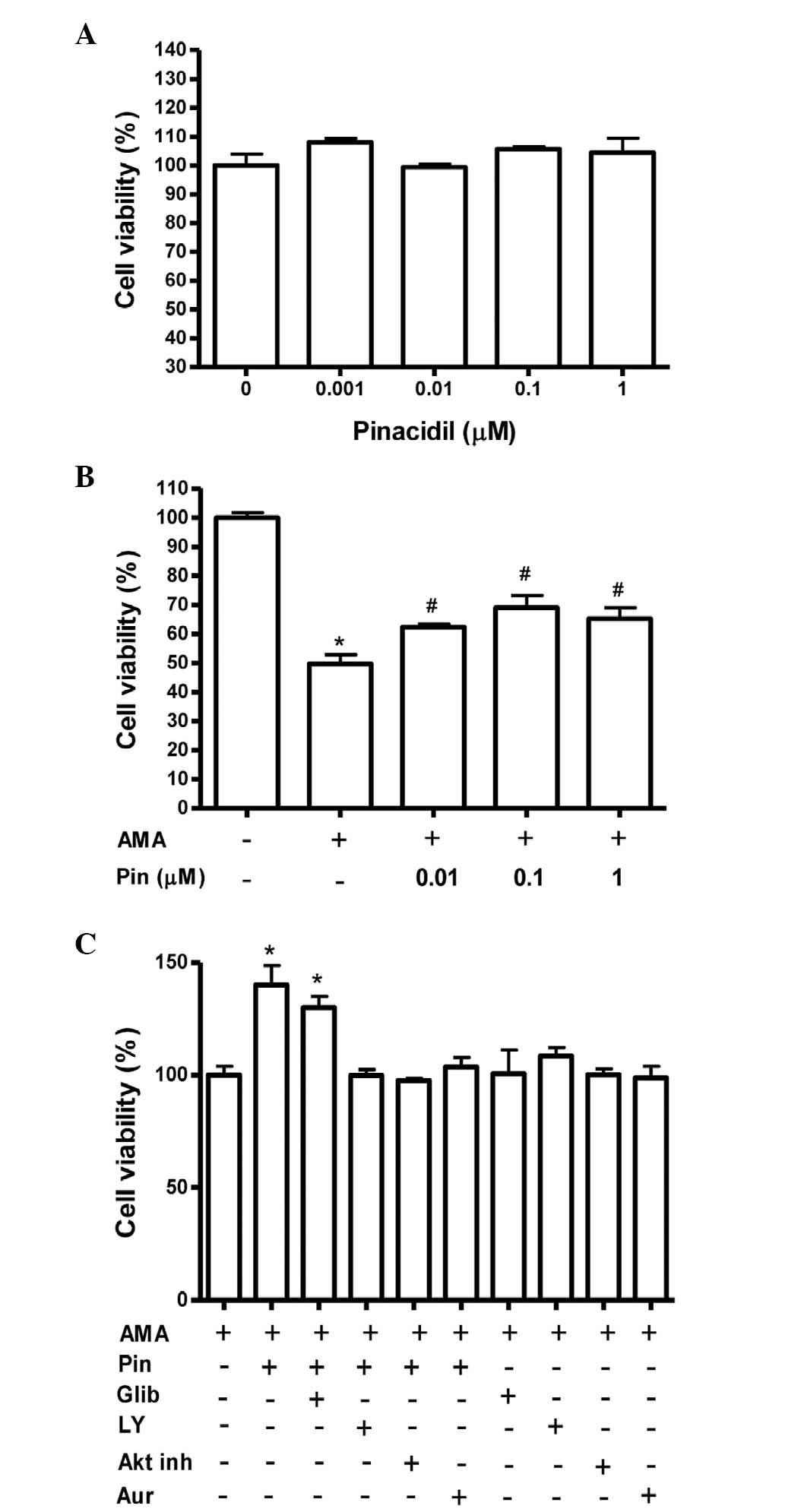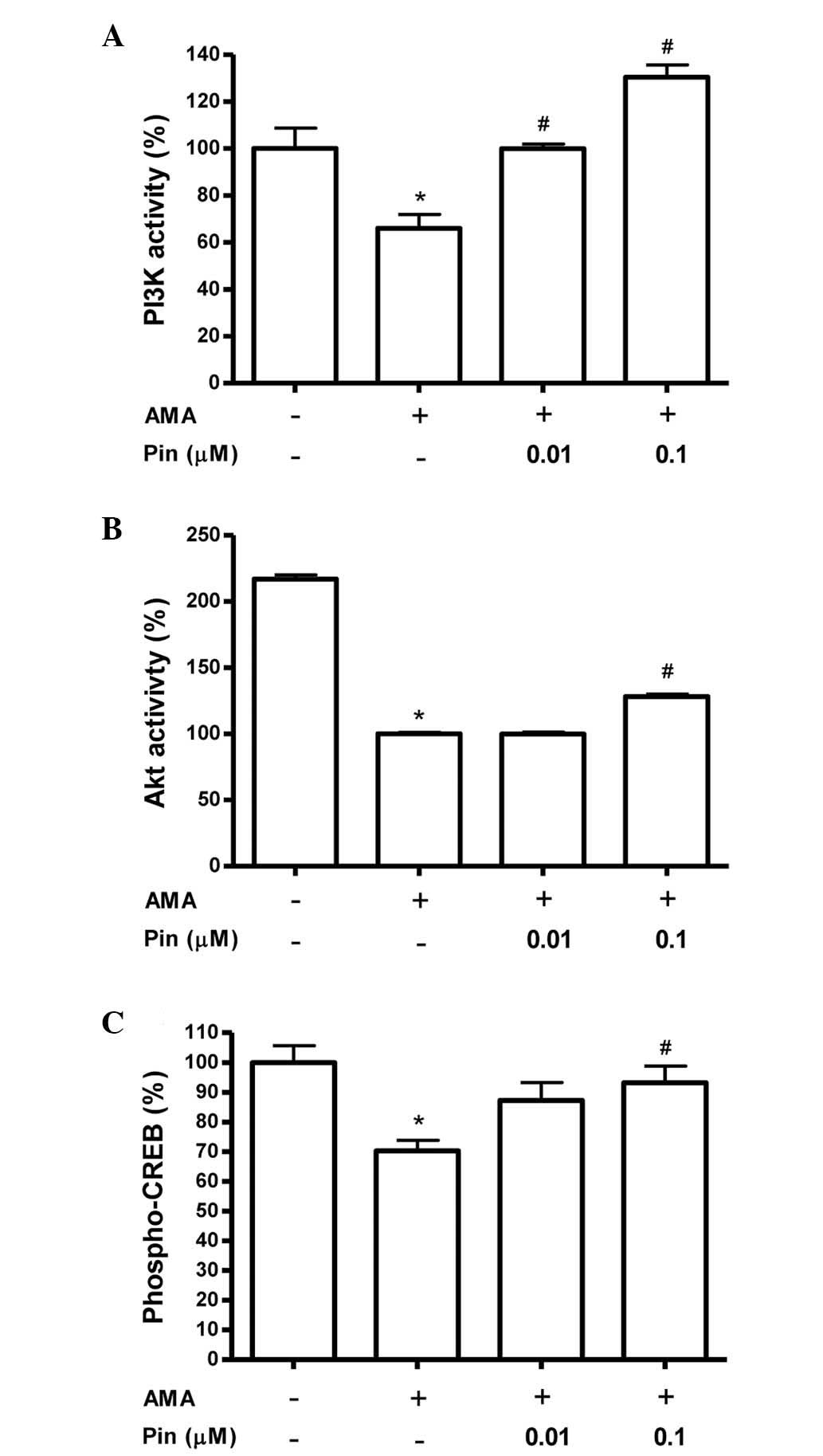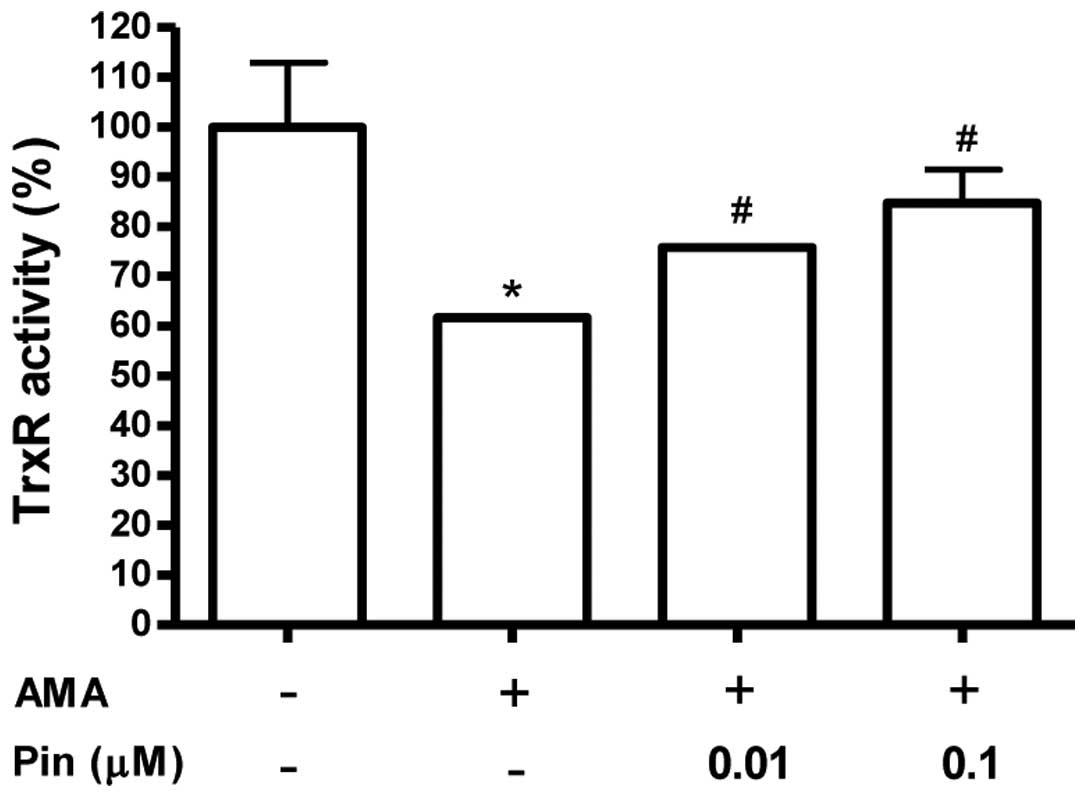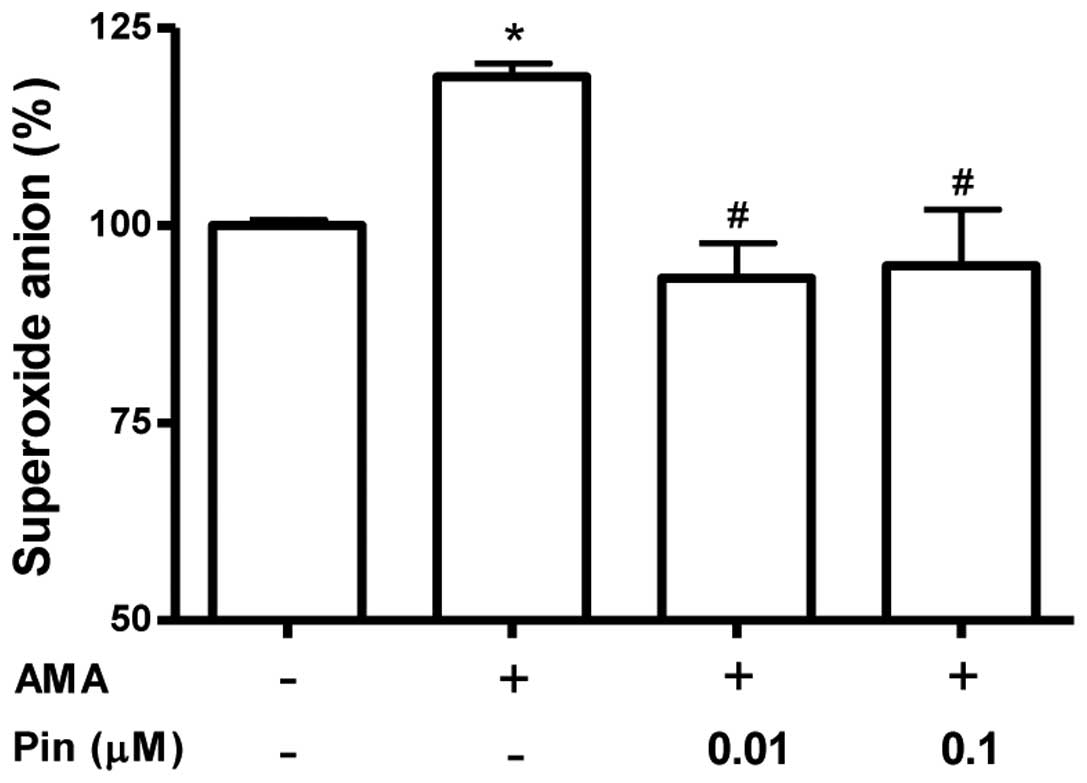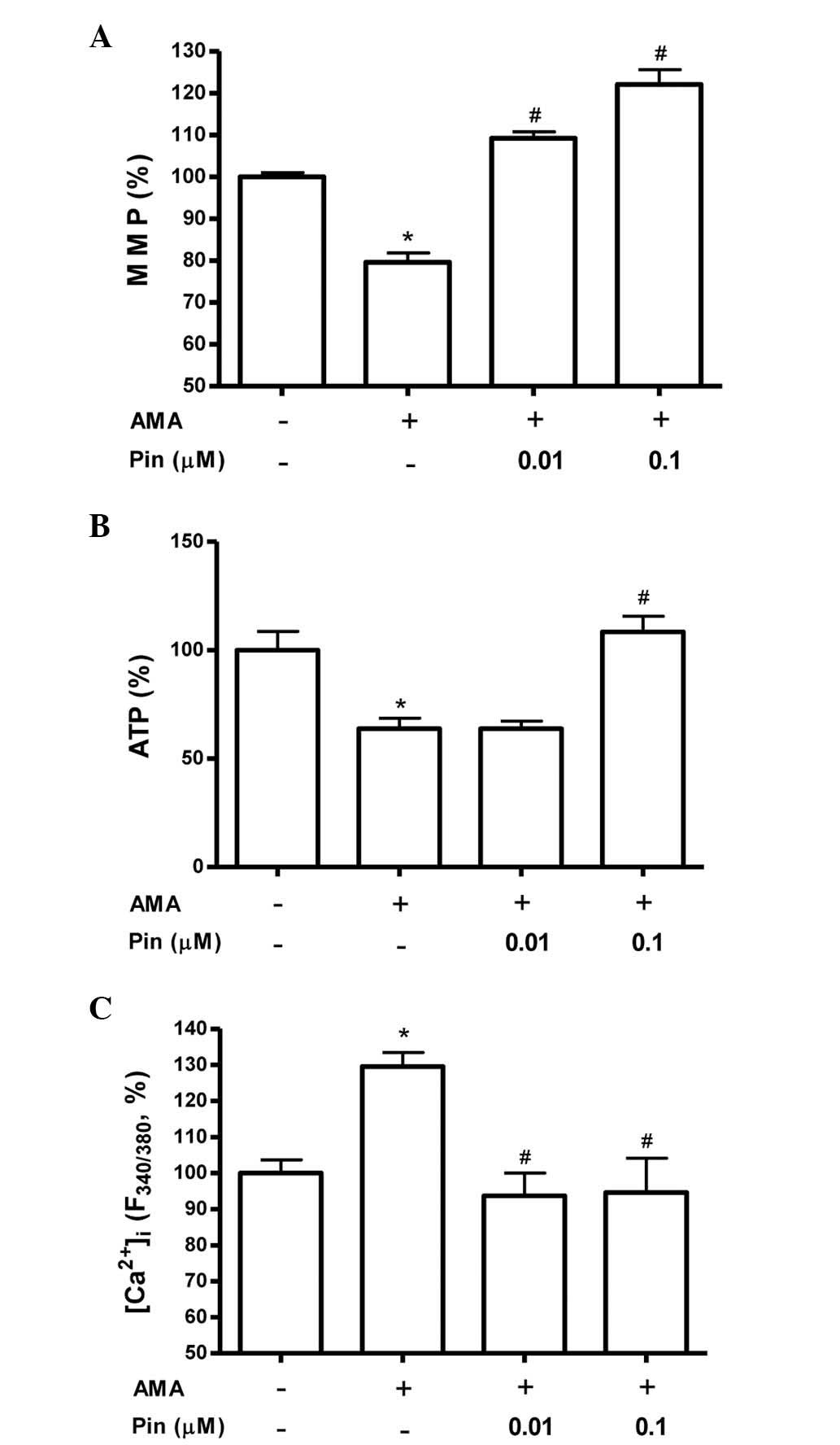Pinacidil protects osteoblastic cells against antimycin A-induced oxidative damage
- Authors:
- Published online on: October 21, 2014 https://doi.org/10.3892/mmr.2014.2721
- Pages: 746-752
Abstract
Introduction
Pinacidil is an antihypertensive drug, which reduces blood pressure by directly relaxing vascular smooth muscle, resulting in vasodilation of peripheral arterioles. Pinacidil is primarily a mitochondrial adenosine triphosphate (ATP)-sensitive potassium channel (mito-KATP) opener (1). The structure and mechanism of action of pinacidil are distinct from those of other commonly used antihypertensive drugs (1). Pinacidil pharmacology has been studied in numerous types of smooth muscle, including cardiac vascular, tracheal, bladder and neuronal tissues (2). In a previous study, pinacidil prevented subarachnoid hemorrhage-induced vasospasm by the restoration of large-conductance Ca2+-activated K+ channel activities (3). Furthermore, pinacidil pre-treatment was able to exert significant protective effects following hemorrhagic shock, mainly by the activation of protein kinase C (PKC)α and PKCɛ via adenosine receptor A1, which restored vascular reactivity and calcium sensitivity and influenced the success of hemorrhagic shock therapy (4). Pinacidil was also demonstrated to enhance the survival of cryopreserved human embryonic stem cells (hESCs) (5). Following plating of thawed hESCs, pinacidil significantly enhanced cell attachment capacity. Previous studies have focused on investigating the function of pinacidil in the heart and coronary artery in order to elucidate the mechanism underlying its protective effects (4). It was hypothesized that the activation and opening of the mito-KATP (6) and the sarcolemmal KATP channel (7) may be beneficial in the restoration of mitochondrial energy metabolism by closing the mitochondrial transition pore (MTP), which stabilizes the mitochondrial membrane potential (MMP) and reduces intracellular Ca2+ levels (8). KATP channels function in the coupling of redox potential (9) and/or mediating free-radical release in mitochondria (10). Activation of mito-KATP produces an increase in the matrix volume of mitochondria, which may result in the activation of the electron transport chain (11).
Oxidative stress is caused by excessive reactive oxygen species (ROS) formation; therefore, an increase in the production of ROS and reactive nitrogen species results in mitochondrial dysfunction, cellular damage and cell death in numerous degenerative diseases and aging (12). Osteoporosis is one such pathological condition in which markedly increased levels of oxidative stress markers are detected in the blood (13). Osteoporosis is primarily associated with aging and mitochondrial dysfunction is implicated in the ageing process where the respiratory chain represents a potential source of ROS (14).
Antimycin A inhibits mitochondrial electron transport by binding to complex III (15). Inhibition of electron transport results in disruption of the proton gradient across the mitochondrial inner membrane, perturbing the MMP and inducing the production of ROS. In a previous study by our group, it was demonstrated that pinacidil stimulated osteoblast differentiation and decreased the osteoclast differentiation-inducing factors promoted by antimycin A (16). However, the mechanism of action of the mito-KATP opener pinacidil in osteoblastic cells remains to be elucidated. The pinacidil-induced cellular protection may be produced via a mitochondrial pathway and this effect may therefore influence the total cellular energy turnover. Mitochondria are one of the key cellular organelles involved in mediating energy metabolism and oxidative stress; therefore, in the present study, the protective effects of pinacidil against antimycin A-induced cytotoxicity were investigated using osteoblastic MC3T3-E1 cells, a model frequently used to study osteogenic development in vitro.
Materials and methods
Reagents
Pinacidil was purchased from Sigma-Aldrich (St. Louis, MO, USA). α-modified minimal essential medium (α-MEM) and fetal bovine serum (FBS) were purchased from Gibco-BRL (Invitrogen Life Technologies, Carlsbad, CA, USA). Other reagents were purchased from Sigma-Aldrich and were of the highest commercial grade available.
Cell culture
Mouse osteoblastic MC3T3-E1 cells were obtained from American Type Culture Collection (Manassas, VA, USA) and cultured at 37°C in a 5% CO2 atmosphere in α-MEM. Unless otherwise specified, the medium contained 10% heat-inactivated FBS, 100 U/ml penicillin and 100 μg/ml streptomycin. The cells were treated, at confluence, with culture medium containing 5 mM β-glycerophosphate and 50 μg/ml ascorbic acid to initiate differentiation. Following three days of culture, the cells were pre-incubated with pinacidil for 1 h prior to treatment with antimycin A for 48 h (17).
Cell viability
To investigate the molecular pathway underlying the protective effect of pinacidil on cell viability, 0.1 μM glibenclamide (a KATP channel inhibitor), 0.1 μM LY294002 (a PI3K inhibitor), 0.1 μM GSK690693 (an Akt inhibitor) and 0.2 μM auranofin (a thioredoxin reductase inhibitor) were used. All inhibitors were purchased from Sigma-Aldrich. Cell viability was determined via reduction of MTT by nicotinamide adenine dinucleotide-dependent dehydrogenase activity to form a colored reaction product (18). MTT (0.5 mg/ml in PBS) was added to each well and the plates were incubated for an additional 2 h. Following removal of the solutions in each well, dimethyl sulfoxide (DMSO) was added to dissolve the formazan products and the plates were agitated for 5 min. The absorbance of each well was recorded using a microplate spectrophotometer (Zenyth 3100 multimode detector; Anthos Labtec Instruments GmbH, Salzburg, Austria) at 570 nm.
Measurement of PI3K activity
PI3K activity in cell lysates was evaluated using a PI3 kinase ELISA kit (Echelon Biosciences, Inc., Salt Lake City, UT, USA) (18). The assay was a competitive ELISA in which the signal was inversely proportional to the amount of PI(3,4,5)P3 produced. Following completion of the PI3K reactions, the reaction products were mixed and incubated with a PI(3,4,5)P3 detector protein, and then added to the PI(3,4,5)P3-coated microplate for competitive binding. A peroxidase-linked secondary detector and colorimetric detection were used to identify PI(3,4,5)P3 detector binding to the plate. The colorimetric signal was inversely proportional to the amount of PI(3,4,5)P3 produced by PI3K.
Measurement of Akt activity
Akt activity in cell lysates was examined using an Akt Kinase Activity kit (Enzo Life Sciences, Inc., Farmingdale, NY, USA) according to the manufacturer’s instructions. The substrate, which was readily phosphorylated by Akt, was pre-coated onto the wells of the Akt microtiter plate supplied. The samples for assay were added to the appropriate wells, followed by the addition of ATP to initiate the reaction. The kinase reaction was terminated and a phosphospecific substrate antibody, which binds specifically to the phosphorylated peptide substrate, was added to the wells. The phosphospecific antibody was subsequently bound by a peroxidase-conjugated secondary antibody and the assay was developed with tetramethylbenzidine substrate. The color developed in proportion to the level of Akt phosphotransferase activity.
Measurement of phosphorylated CREB
Phosphorylated CREB levels were evaluated using Cell-Based Phospho-CREB (S133) immunoassay (R&D Systems, Inc., Mineappolis, MN, USA) (19). This cell-based kit contained the components required to run an ELISA using fluorogenic substrates to measure phosphorylated CREB (S133) levels in whole cells. Following stimulation with agents, cells were fixed and permeabilized in the wells. The target protein phosphorylation was measured using a double immunoenzymatic labeling procedure. The cells were simultaneously incubated with two primary antibodies: A phospho-specific antibody and a normalization antibody that recognizes the pan-protein regardless of phosphorylation status. The primary antibodies were derived from different species. Two secondary antibodies labeled with horseradish peroxidase (HRP) or alkaline phosphatase (AP) and two spectrally distinct fluorogenic substrates for HRP or AP were used for detection using a Zenyth 3100 multimode detector (Anthos Labtec Instruments GmbH). The fluorescence of the phosphorylated protein was normalized to that of the pan-protein in that well in order to correct well-to-well variations.
Measurement of thioredoxin reductase (TrxR) activity
TrxR activity was measured using an enzyme activity assay kit (TrxR ELISA kit; Cayman Chemical Co., Ann Arbor, MI, USA). Cells were homogenized in lysis buffer [20 mM 3-(N-morpholino)propanesulfonic acid, 50 mM sodium fluoride, 1 mM sodium vanadate, 5 mM ethylene glycol tetraacetic acid, 2 mM EDTA, 1% nonyl phenoxypolyethoxylethanol, 1 mM dithiothreitol, 1 mM benzamidine, 1 mM phenylmethylsulfonyl fluoride and 1% protease inhibitor cocktail (pH 7.2)]. Following centrifugation at 10,000 xg for 15 min at 4°C, the supernatant was used as a cell lysate for assay.
Measurement of mitochondrial superoxide
Mitochondrial superoxide levels were detected using MitoSOXTM Red mitochondrial superoxide indicator (Molecular Probes®; Life Technologies) (18). MitoSOXTM Red (Excitation/Emission (Ex/Em)=510/580 nm) is a fluorogenic dye for selective detection of superoxide in the mitochondria of cells. Cells were incubated with 5 μM MitoSOXTM Red at 37°C for 20 min according to the manufacturer’s instructions. Following washing of the cells, the MitoSOXTM Red fluorescence was detected using a fluorescence microplate reader (Molecular Devices, LLC, Sunnyvale, CA, USA).
Determination of MMP
The JC-1 mitochondrial membrane potential assay kit (Cayman Chemical Co.) was used to investigate changes in the MMP of cells (19). JC-1 is a lipophilic and cationic dye, which permeates plasma and mitochondrial membranes. The dye fluoresces red when it aggregates in healthy mitochondria with high membrane potential, whereas it appears in monomeric form and therefore fluoresces green in mitochondria with diminished membrane potential. Cells were incubated with JC-1 for 20 min at 37°C, washed twice in PBS and then the ‘red’ (Ex/Em=550/600 nm) and ‘green’ (Ex/Em=485/535 nm) fluorescence was measured using a fluorescence microplate reader (Molecular Devices, LLC). Mitochondrial depolarization (loss of MMP) was indicated by a decrease in the red/green fluorescence ratio.
Measurement of ATP levels
The ATP concentration was determined by luciferase reaction using the EnzyLight™ ATP Assay kit (BioAssay Systems, Hayward, CA, USA). This ATP assay provided a rapid method for the measurement of intracellular ATP. Protein concentrations were determined using the BioRad protein assay reagent (Bio-Rad Laboratories, Hercules, CA, USA) and detected using a Zenyth 3100 multimode detector (Anthos Labtec Instruments GmbH) according to the manufacturer’s instructions.
Intracellular Ca2+ measurement
Osteoblastic MC3T3-E1 cells were cultured in media containing pinacidil and/or antimycin A. Cells were subsequently treated with 5 μM fura-2-acetoxymethyl ester (AM) for 1 h at 37°C. Following washing with PBS, fluorescence emission (510 nm) was monitored at the excitation wavelengths of 340 and 380 nm using a Gemini XPS microplate reader (Molecular Devices, LLC) according to the manufacturer’s instructions.
Statistical analysis
Experiments were performed in triplicate and values are expressed as the mean ± standard error of the mean. Statistical analysis was performed using SAS software 9.2 (SAS Institute, Inc., Cary, NC, USA) Statistical significance was determined by analysis of variance and subsequently applying the Dunnett’s t-test. P<0.05 was considered to indicate a statistically significant difference between values.
Results
Pinacidil enhances the viability of MC3T3-E1 cells following antimycin A treatment
Cell viability was evaluated by MTT assay. In the absence of antimycin A, pinacidil had no effect on the viability of MC3T3-E1 cells at concentrations ≤1 μM (Fig. 1A). Antimycin A (70 μM) significantly decreased the cell viability of osteoblasts, whereas pinacidil pretreatment (0.01–1 μM) increased cell viability compared with that of antimycin A-treated cells (Fig. 1B). These results indicated that pinacidil exerted a protective effect against antimycin A-induced cytotoxicity. Furthermore, the protective effects of pinacidil on cell viability were perturbed by the presence of LY294002 (a PI3K inhibitor), GSK690693 (an Akt inhibitor) or auranofin (thioredoxin reductase inhibitor), but not by glibenclamide (KATP channel inhibitor), indicating that the effect of pinacidil may be mediated by PI3K, Akt and/or thioredoxin reductase activity (Fig. 1C).
Pinacidil rescues the activation of PI3K, Akt and CREB in the presence of antimycin A
The PI3K/Akt/CREB signaling pathway is known to function as a pro-survival signal (18,19). The role of PI3K/Akt/CREB activation in mediating the cytoprotective effects of pinacidil in MC3T3-E1 cells was therefore investigated. Following treatment of the cultures with 70 μM antimycin A, in the presence or absence of pinacidil, PI3K and Akt activities were measured. As shown in Fig. 2A and B, the results of these experiments indicated that antimycin A decreased PI3K and Akt activities and pretreatment with pinacidil prevented this decline in activity in cells at concentrations of 0.01–0.1 μM and 0.1 μM, respectively. Treatment with antimycin A inhibited phosphorylation of CREB, while pinacidil pre-treatment (0.1 μM) rescued CREB phophorylation levels (P<0.05; Fig. 2C).
Pinacidil has an antioxidant effect in osteoblastic MC3T3-E1 cells
Activation of thioredoxin reductase (TrxR) was also considered as a potential mechanism underlying the cytoprotective effects of pinacidil. The effect of pinacidil on TrxR activity was evaluated using the 5,5′-dithiobis(2-nitrobenzoic) acid reduction assay. Exposure of MC3T3-E1 cells to antimycin A resulted in a significant decrease in TrxR activity (Fig. 3). This inhibitory effect of antimycin A was counteracted by pre-treatment with pinacidil (0.01 and 0.1 μM).
The effect of pinacidil on mitochondrial superoxide production was measured using MitoSOX, a live-cell-permeable and mitochondrial localizing superoxide indicator. MitoSOX is derived from dihydroethidium, conjugated to a triphenylphosphonium moiety and has a positive charge, which results in its accumulation within the mitochondrial matrix (18). As indicated in Fig. 4, mitochondrial MitoSOX fluorescence was increased following antimycin A treatment; however, pinacidil (0.01 and 0.1 μM) pre-treatment inhibited the mitochondrial superoxide production induced by antimycin A.
Pinacidil attenuates antimycin A-induced mitochondrial dysfunction in osteoblastic MC3T3-E1 cells
When cells are subjected to oxidative stress, mitochondrial membrane integrity is lost, which initiates a signaling cascade resulting in cell death. To investigate the mitochondrial function of osteoblasts, MMP and ATP content were assayed following treatment of MC3T3-E1 cells with antimycin A in the presence or absence of pinacidil. As shown in Fig. 5A, a decrease in MMP occurred following exposure to antimycin A. Pinacidil (0.01 and 0.1 μM) abrogated this reduction in MMP, suggesting that pinacidil pre-treatment may be able to maintain the membrane potential of these cells, thereby precluding this induced cell death. ATP levels were evaluated using a standard luminescent luciferin/luciferase assay. As illustrated in Fig. 5B, the levels of ATP in osteoblasts decreased following antimycin A treatment. However, pinacidil (0.1 μM) pre-treatment significantly increased intracellular ATP levels when compared with those of the antimycin A group. The intracellular calcium concentration ([Ca2+]i) has been demonstrated to have a role in cell death, and alterations in [Ca2+]i were therefore measured using the Fura-2AM fluorescence technique. Osteoblastic MC3T3-E1 cells were cultured in media containing pinacidil and/or antimycin A. Subsequently, following incubation with Fura-2AM, [Ca2+]i levels were measured. As depicted in Fig. 5C, antimycin A markedly increased [Ca2+]i, an effect that was significantly attenuated by pinacidil (0.01 and 0.1 μM). In conclusion, the results of the present study indicated that the cytoprotective effect of pinacidil resulted from its function in mitochondrial protection.
Discussion
The present study demonstrated the cytoprotective effects of pinacidil against antimycin A-induced damage in osteoblastic MC3T3-E1 cells. Pinacidil enhanced the antimycin A-inhibited PI3K and Akt activity and CREB phosphorylation. Activation of Akt has a crucial function in regulating fundamental cellular functions, including cell proliferation and survival, by phosphorylation of numerous substrates. PI3K/Akt signaling prevents mitochondrial cytochrome c release by indirectly influencing cellular metabolism, which sustains mitochondrial integrity (20). CREB is a cellular transcription factor, which is activated in part by the phosphorylation of serine at position 133. Following activation, CREB induces transcription of various downstream genes. Cammarota et al (21) reported that CREB was localized to the inner mitochondrial compartment, in addition to localization in the nucleus. Mitochondrial CREB was hypothesized to mediate pro-survival effects by regulating various mitochondrial genes, the expression of which may be directed by CRE-like elements located in the D-loop of the mitochondrial genome (22). Furthermore, Lee et al (23) demonstrated that the binding of CREB to CRE sequences in the D-loop of mitochondrial DNA enhanced the transcript levels of mitochondrial genes. Therefore, the results of the present study suggested that the protective effects of pinacidil in osteoblasts may be associated with PI3K, Akt and CREB signaling.
Trx is a protein ubiquitously expressed in living cells, which performs numerous functions associated with cell proliferation and apoptosis (24) and additionally confers cytoprotection against cellular damage by oxidative stress (25). In the present study, TrxR activity was demonstrated to be reduced following antimycin A treatment, an effect which was reversed by pinacidil pre-treatment. Previous in vitro studies indicated that Trx was able to inhibit apoptosis-regulating kinase-1 (ASK-1) activity. ASK-1 is a mitogen-activated protein kinase (MARK) that activates pro-apoptotic protein kinases (24); therefore, ASK-1 inhibition has a protective effect against damage resulting from oxidative stress (26). The Trx system is the most important factor in the regulation of the intracellular redox environment, which influences the redox state, antioxidant defense and redox regulation of multiple cellular processes (27). TrxR regulates the redox state of cells via detoxification of hydrogen peroxide and lipid peroxides (28), regeneration of ascorbic acid (29) and by enhancing superoxide dismutase activity (30). Therefore, the present study hypothesized that the protective effect of pinacidil against cell damage due to redox disruption may be mediated by an upregulation of the Trx system.
Inhibition of enzymes in the mitochondrial respiratory chain may result in aberrant single-electron reduction of molecular oxygen to superoxide (13). It is therefore critical that superoxide-induced redox signaling in the mitochondria is prevented. Increased mitochondrial superoxide levels lead to enhanced transferrin receptor expression, which results in increases in iron uptake and generation of various lipid aldehyde signaling molecules (31). Mitochondrial-generated superoxide was demonstrated to activate uncoupling proteins via the formation of lipid peroxidation breakdown products (32). In the present study, pinacidil was demonstrated to markedly attenuate the production of superoxide in the mitochondria induced by antimycin A treatment, which indicated that the cytoprotective effect of pinacidil may be associated with its antioxidative functions.
ATP synthesis, the primary function of mitochondria, is mediated by oxidative phosphorylation and associated with cell redox status (33). The transfer of electrons from complex I to V generates a proton concentration gradient across the inner mitochondrial membrane, sustaining the MMP and driving ATP synthesis (34). A failure of efficient electron transport and ATP synthesis induced by oxidative stress results in the accumulation of free radicals and leads to mitochondrial dysfunction (35). In the present study, pre-treatment with pinacidil was found to increase ATP synthesis. This result suggested that pinacidil pre-treatment normalized oxidative phosphorylation rates, thereby increasing mitochondrial energy metabolism. This led to the hypothesis that one of the mechanisms by which pinacidil confers protection against oxidative stress may be by directly enhancing the rate of ATP synthesis.
The integrity of the mitochondrial membrane structure is also important in maintaining normal cell function, as it is associated with mitochondrial functions, including the transmembrane proton gradient and ATP energy production (36). It has been suggested that mitochondrial dysfunction may be responsible for numerous human disorders (37). The majority of the proton motive force of mitochondria is in the form of the MMP; therefore, the MMP may be used as a measure of mitochondrial function in cellular homeostasis. A decrease in MMP results in a reduction in mitochondrial dehydrogenase activity, depressed oxidative phosphorylation enzyme complex function and therefore a decrease in ATP synthesis. In the present study, pretreatment of MC3T3-E1 cells with pinacidil reversed the antimycin A-induced decline in MMP, which suggested that pinacidil may inhibit the opening of the MTP and prevent mitochondrial depolarization, averting osteoblast death. Therefore, mitochondria had an important role in mediating the protective effects of pinacidil in damaged MC3T3-E1 cells.
Antimycin A increased the cytosolic Ca2+ concentration, an effect that was attenuated by pinacidil treatment. Ca2+ enhances cytochrome c displacement from the mitochondrial inner membrane by competing for cardiolipin binding sites or inducing the cytochrome c releasing process during MTP opening (38). MTP opening allows the passage of protons through the mitochondrial membrane and is therefore associated with a rapid depolarization of the mitochondria and subsequent uncoupling of oxidative phosphorylation (39). It was therefore hypothesized that pinacidil may inhibit cytochrome c release by mediating a reduction in intracellular calcium concentration.
In conclusion, pinacidil protected osteoblastic cells against antimycin A-induced cell damage by enhancing mitochondrial function and rescuing activation of PI3K, Akt and CREB. Furthermore, pinacidil may potentially be used to protect mitochondria against bursts of oxidative stress in osteoblastic cells.
Acknowledgements
The present study was supported by the Basic Science Research Program through the National Research Foundation of Korea, funded by the Ministry of Education (no. NRF-2013R1A1A2A10004361).
References
|
Friedel HA and Brogden RN: Pinacidil. A review of its pharmacodynamic and pharmacokinetic properties, and therapeutic potential in the treatment of hypertension. Drugs. 39:929–967. 1990.PubMed/NCBI | |
|
Jahangir A and Terzic A: K(ATP) channel therapeutics at the bedside. J Mol Cell Cardiol. 39:99–112. 2005. View Article : Google Scholar : PubMed/NCBI | |
|
Chen JY, Cheng KI, Tsai YL, Hong YR, Howng SL, Kwan AL, Chen IJ and Wu BN: Potassium-channel openers KMUP-1 and pinacidil prevent subarachnoid hemorrhage-induced vasospasm by restoring the BKCa-channel activity. Shock. 38:203–212. 2012. View Article : Google Scholar | |
|
Xu J, Li T, Yang G and Liu L: Pinacidil pretreatment improves vascular reactivity after shock through PKCα and PKCɛ in rats. J Cardiovasc Pharmacol. 59:514–522. 2012.PubMed/NCBI | |
|
Barbaric I, Jones M, Buchner K, Baker D, Andrews PW and Moore HD: Pinacidil enhances survival of cryopreserved human embryonic stem cells. Cryobiology. 63:298–305. 2011. View Article : Google Scholar : PubMed/NCBI | |
|
Hanley PJ and Daut J: K(ATP) channels and preconditioning: a re-examination of the role of mitochondrial K(ATP) channels and an overview of alternative mechanisms. J Mol Cell Cardiol. 39:17–50. 2005. View Article : Google Scholar : PubMed/NCBI | |
|
Yang L and Yu T: Prolonged donor heart preservation with pinacidil: the role of mitochondria and the mitochondrial adenosine triphosphate-sensitive potassium channel. J Thorac Cardiovasc Surg. 139:1057–1063. 2010. View Article : Google Scholar | |
|
Downey JM, Davis AM and Cohen MV: Signaling pathways in ischemic preconditioning. Heart Fail Rev. 12:181–188. 2007. View Article : Google Scholar : PubMed/NCBI | |
|
O’Rourke B, Ramza BM and Marban E: Oscillations of membrane current and excitability driven by metabolic oscillations in heart cells. Science. 265:962–966. 1994. | |
|
Hoppeler H, Vogt M, Weibel ER and Flück M: Response of skeletal muscle mitochondria to hypoxia. Exp Physiol. 88:109–119. 2003. View Article : Google Scholar : PubMed/NCBI | |
|
Das M, Parker JE and Halestrap AP: Matrix volume measurements challenge the existence of diazoxide/glibencamide-sensitive KATP channels in rat mitochondria. J Physiol. 547(Pt 3): 893–902. 2003.PubMed/NCBI | |
|
Beal MF: Mitochondria, free radicals, and neurodegeneration. Curr Opin Neurobiol. 6:661–666. 1996. View Article : Google Scholar : PubMed/NCBI | |
|
Maggio D, Barabani M, Pierandrei M, Polidori MC, Catani M, Mecocci P, Senin U, Pacifici R and Cherubini A: Marked decrease in plasma antioxidants in aged osteoporotic women: results of a cross-sectional study. J Clin Endocrinol Metab. 88:1523–1527. 2003. View Article : Google Scholar : PubMed/NCBI | |
|
Brookes PS, Yoon Y, Robotham JL, Anders MW and Sheu SS: Calcium, ATP, and ROS: a mitochondrial love-hate triangle. Am J Physiol Cell Physiol. 287:C817–C833. 2004. View Article : Google Scholar : PubMed/NCBI | |
|
Pham NA, Robinson BH and Hedley DW: Simultaneous detection of mitochondrial respiratory chain activity and reactive oxygen in digitonin-permeabilized cells using flow cytometry. Cytometry. 41:245–251. 2000. View Article : Google Scholar : PubMed/NCBI | |
|
Suh KS, Lee YS and Choi EM: Pinacidil stimulates osteoblast function in osteoblastic MC3T3-E1 cells. Immunopharm Immunotoxicol. 35:359–364. 2013. View Article : Google Scholar : PubMed/NCBI | |
|
Choi EM: Protective effect of diazoxide against antimycin A-induced mitochondrial dysfunction in osteoblastic MC3T3-E1 cells. Toxicol In Vitro. 25:1603–1608. 2011. View Article : Google Scholar : PubMed/NCBI | |
|
Choi EM, Suh KS and Lee YS: Liquiritigenin restores osteoblast damage through regulating oxidative stress and mitochondrial dysfunction. Phytother Res. 28:880–886. 2014. View Article : Google Scholar : PubMed/NCBI | |
|
Suh KS, Lee YS, Kim YS and Choi EM: Sciadopitysin protects osteoblast function via its antioxidant activity in MC3T3-E1 cells. Food Chem Toxicol. 58:220–227. 2013. View Article : Google Scholar : PubMed/NCBI | |
|
Kennedy SG, Kandel ES, Cross TK and Hay N: Akt/protein kinase B inhibits cell death by preventing the release of cytochrome c from mitochondria. Mol Cell Biol. 19:5800–5810. 1999.PubMed/NCBI | |
|
Cammarota M, Paratcha G, Bevilaqua LR, Levi de Stein M, Lopez M, Pellegrino de Iraldi A, Izquierdo I and Medina JH: Cyclic AMP-responsive element binding protein in brain mitochondria. J Neurochem. 72:2272–2277. 1999. View Article : Google Scholar : PubMed/NCBI | |
|
Ryu H, Lee J, Impey S, Ratan RR and Ferrante RJ: Antioxidants modulate mitochondrial PKA and increase CREB binding to D-loop DNA of the mitochondrial genome in neurons. Proc Natl Acad Sci USA. 102:13915–13920. 2005. View Article : Google Scholar : PubMed/NCBI | |
|
Lee J, Kim CH, Simon DK, Aminova LR, Andreyev AY, Kushnareva YE, et al: Mitochondrial cyclic AMP response element-binding protein (CREB) mediates mitochondrial gene expression and neuronal survival. J Biol Chem. 280:40398–40401. 2005. View Article : Google Scholar : PubMed/NCBI | |
|
Tao L, Gao E, Bryan NS, Qu Y, Liu HR, Hu A, Christopher TA, Lopez BL, Yodoi J, Koch WJ, Feelisch M and Ma XL: Cardioprotective effects of thioredoxin in myocardial ischemia and reperfusion: role of S-nitrosation. Proc Natl Acad Sci USA. 101:11471–11476. 2004. View Article : Google Scholar : PubMed/NCBI | |
|
Yoshida T, Oka S, Masutani H, Nakamura H and Yodoi J: The role of thioredoxin in the aging process: involvement of oxidative stress. Antioxid Redox Signal. 5:563–570. 2003. View Article : Google Scholar : PubMed/NCBI | |
|
Liu Y and Min W: Thioredoxin promotes ASK1 ubiquitination and degradation to inhibit ASK1-mediated apoptosis in a redox activity-independent manner. Circ Res. 90:1259–1266. 2002. View Article : Google Scholar : PubMed/NCBI | |
|
Lemarechal H, Anract P, Beaudeux JL, Bonnefont-Rousselot D, Ekindjian OG and Borderie D: Impairment of thioredoxin reductase activity by oxidative stress in human rheumatoid synoviocytes. Free Radic Res. 41:688–698. 2007. View Article : Google Scholar : PubMed/NCBI | |
|
Björnstedt M, Hamberg M, Kumar S, Xue J and Holmgren A: Human thioredoxin reductase directly reduces lipid hydroperoxides by NADPH and selenocystine strongly stimulates the reaction via catalytically generated selenols. J Biol Chem. 270:11761–11764. 1995. | |
|
May JM, Mendiratta S, Hill KE and Burk RF: Reduction of dehydroascorbate to ascorbate by the selenoenzyme thioredoxin reductase. J Biol Chem. 272:22607–22610. 1997. View Article : Google Scholar : PubMed/NCBI | |
|
Das KC, Lewis-Molock Y and White CW: Elevation of manganese superoxide dismutase gene expression by thioredoxin. Am J Respir Cell Mol Biol. 17:713–726. 1997. View Article : Google Scholar : PubMed/NCBI | |
|
Jouihan HA, Cobine PA, Cooksey RC, Hoagland EA, Boudina S, Abel ED, Winge DR and McClain DA: Iron-mediated inhibition of mitochondrial manganese uptake mediates mitochondrial dysfunction in a mouse model of hemochromatosis. Mol Med. 14:98–108. 2008. View Article : Google Scholar : PubMed/NCBI | |
|
Echtay KS, Esteves TC, Pakay JL, Jekabsons MB, Lambert AJ, Portero-Otin M, Pamplona R, Vidal-Puig AJ, Wang S, Roebuck SJ and Brand MD: A signalling role for 4-hydroxy-2-nonenal in regulation of mitochondrial uncoupling. EMBO J. 22:4103–4110. 2003. View Article : Google Scholar : PubMed/NCBI | |
|
Thorburn DR: Diverse powerhouses. Nature Genet. 36:13–14. 2004. View Article : Google Scholar | |
|
Mourier A and Larsson NG: Tracing the trail of protons through complex I of the mitochondrial respiratory chain. PLoS Biol. 9:e10011292011. View Article : Google Scholar : PubMed/NCBI | |
|
Zhang DX and Gutterman DD: Mitochondrial reactive oxygen species-mediated signaling in endothelial cells. Am J Physiol Heart Circ Physiol. 292:H2023–H2031. 2007. View Article : Google Scholar : PubMed/NCBI | |
|
Tsujimoto Y and Shimizu S: Role of the mitochondrial membrane permeability transition in cell death. Apoptosis. 12:835–840. 2007. View Article : Google Scholar : PubMed/NCBI | |
|
Weissig V: Mitochondrial-targeted drug and DNA delivery. Crit Rev Ther Drug Carrier Syst. 20:1–62. 2003. View Article : Google Scholar : PubMed/NCBI | |
|
Hajnóczky G, Csordás G, Das S, Garcia-Perez C, Saotome M, Sinha Roy S and Yi M: Mitochondrial calcium signaling and cell death: approaches for assessing the role of mitochondrial Ca2+ uptake in apoptosis. Cell Calcium. 40:553–560. 2006.PubMed/NCBI | |
|
Tonin AM, Amaral AU, Busanello EN, Grings M, Castilho RF and Wajner M: Long-chain 3-hydroxy fatty acids accumulating in long-chain 3-hydroxyacyl-CoA dehydrogenase and mitochondrial trifunctional protein deficiencies uncouple oxidative phosphorylation in heart mitochondria. J Bioenerg Biomemb. 45:47–57. 2013. View Article : Google Scholar |



